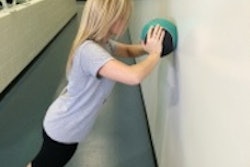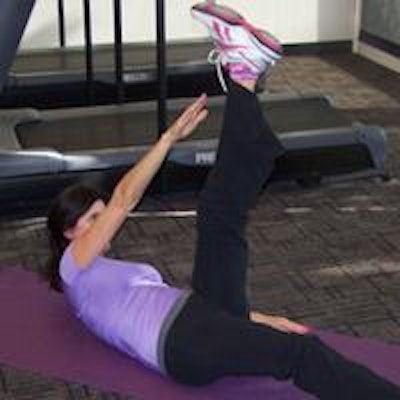
I was scared and stressed out. With my shoulder areas in constant, near-debilitating pain, I didn't know if my body was going to allow me to physically be able to continue my career as an adult and pediatric sonographer. And I know I'm not the only one who has been through this experience.
However, for several years now, I have been able to scan completely free of pain, all thanks to a movement training program. I was lucky because I had access to a National Football League (NFL) strength coach, Mark Roozen. After complaining to him one day about my issues, Mark took a look at the mechanics and the ergonomics of my job and gave me some great news: Exercise would help me.
Mark showed me how to exercise by doing the right exercises in the right ways. I did what he said, and in a short period of time, my pain lessened and then ultimately went away. I don't worry about the pain coming back. I do my exercises and life is good. I not only get the benefits of pain-free scanning, I get the benefits of the exercise itself.
I didn't have to spend hours in the gym or hundreds of dollars a year on gym memberships or home workout stations. I saw the majority of my improvement using just resistance rubber bands. A 20-minute workout, three times per week, gave me the joy of pain-free scanning. Once I started my exercise routine, I found that it wasn't hard to incorporate more of a wellness-centered approach into my workout and my life.
Here are some movement training exercises from Mark that can help improve back, hip, and shoulder pain. For additional information, see AuntMinnie.com's previous four-part Scanning in Pain series: part 1, part 2, part 3, and part 4.
Multidirectional exercises
During training, we need to remember that we must train movement and not just muscle. What do we mean by this? A person can't just do bicep curls and leg extensions and expect to move better and have the body function better as a whole unit. As we look to set up training programs, the majority of the program should be exercises that include multiple body segments, with some muscles being used for movement, others being used for stability, and others for support. By training in this method, the body can function better as a whole unit, which allows for better "performance," whether that is doing a job, enjoying a hobby, or just improving your everyday life.
The following combination of exercises are great for working the hips, lower back, abdominals, shoulders, and upper back. Doing all the exercises in order will allow the body to train like it moves; in multiple directions, with muscles working in different combinations based on the movement. This allows the individual to feel the whole body work, not just one isolated muscle. It's a great workout for beginners, and as you progress into your workout program, it's a great warm-up that takes less than 10 minutes to accomplish.
To begin, lie on your back on the floor. A mat can be used to soften what you are lying on, but you don't want it so soft that you don't have some type of support for proper movement.
Same arm and leg, from the supine position
While lying on the floor on your back, extend your arm overhead, and lift the same-side leg 6 inches off the ground. To start the exercise, keeping the right arm straight, bring it up over the head. At the same time, lift the right leg and bring it up toward the right arm (figure 1). You will bend at the waist slightly, doing a crunching motion, as you touch the right hand to the toe. If you cannot reach the toe, extend the arm as far as possible and do the range of motion you feel comfortable moving through.
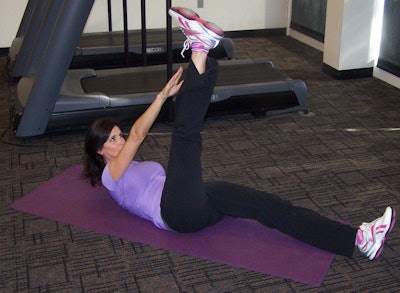 Figure 1.
Figure 1.Do eight repetitions. After eight, change sides, doing the left arm and left leg.
Opposite arm and leg, from the supine position
While lying on the floor on your back, extend your arm overhead. Then lift the opposite leg 6 inches of the ground. To start the exercise, bring your right arm up over your head, keeping it straight. At the same time, lift the left leg and bring it up toward the right arm (figure 2).
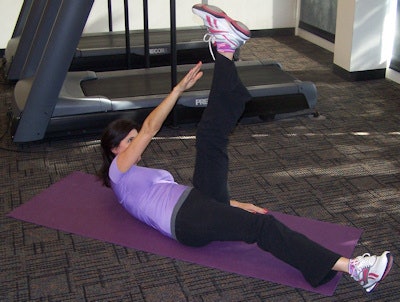 Figure 2.
Figure 2.You will bend at the waist slightly, doing a twisting and crunching motion, as you touch the right hand to the left toe (if you cannot reach the toe, extend the arm as far as possible, and do the range of motion you feel comfortable moving through).
Do eight repetitions. After eight, change sides, doing the left arm and right leg.
Opposite arm and leg at 45°, from the supine position
While lying on the floor on your back, extend your right arm overhead, and then lift the opposite leg 6 inches off the ground. Extend the right arm out to a 45° angle. At the same time, take the left leg and put it out to a 45° angle from the hip. When ready, bring the right arm up and across the body, while at the same time bringing the left leg up and across at an angle to the right hand.
You will bend at the waist slightly, with a twisting and crunching motion, as you touch the right hand to the left toe (if you cannot reach the toe, extend the arm as far as possible, and do the range of motion you feel comfortable moving through).
Do eight repetitions. After eight, alternate and change sides, doing the left arm and right leg and keeping them at a 45° angle as you go through the movement (figure 3).
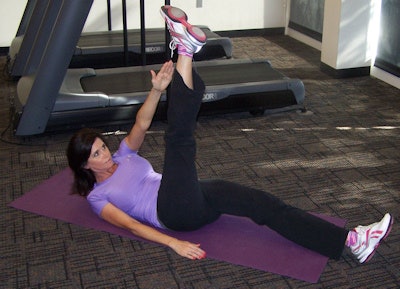 Figure 3.
Figure 3.Opposite arm and leg at 90°, from the supine position
While lying on the floor on your back, extend your right arm straight up in the air. At the same time, raise your left leg straight up. When ready, bring the right arm out so it is extended to the side of the chest, and at the same time bring the left leg out and toward the ground. Try to keep your hips and shoulders on the ground as you bring the arm and leg to the down position.
There will be a slight rotation and lift of the hips and shoulders as you bring the hand and foot together. The other leg and shoulder/arm should maintain contact with the floor. If you cannot reach the toe, extend the arm as far as possible, and do the range of motion you feel comfortable moving through. If you cannot bring the arm or leg to the floor without rotation or lifting the hip or shoulder, just use the range of motion in which you can maintain proper form and technique.
Do eight repetitions. After eight, alternate and change sides, doing the left arm and right leg, keeping them at a 90° angle as you go through the movement (figure 4).
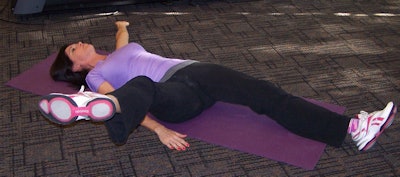 Figure 4.
Figure 4.Same arm and leg, from the prone position
While lying facedown on the floor, extend your right arm overhead and lift the leg on the same side of the body 6 inches off the ground. Keeping the right arm straight, lift from the shoulder and extend and reach out as far as possible; at the same time, lift the right leg from the glute (butt) and push it up and back as far as possible (figure 5).
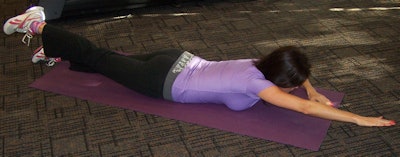 Figure 5.
Figure 5.The key to this group of exercises is not just to lift up into the air, but to extend as far as possible as you raise the leg and arm. (Go through a range of motion and lift only to comfort level. You will be able to increase range of motion and intensity as you progress.)
Do eight repetitions. After eight, alternate and change sides, doing the left arm and left leg.
Opposite arm and leg, from the prone position
While lying facedown on the floor, extend your right arm overhead and the opposite leg 6 inches off the ground. Keeping the right arm straight, lift from the shoulder and extend and reach out as far as possible. At the same time, lift the left leg from the glute (butt) and push it up and back as far as possible.
Again, the key is not just to lift up into the air, but to extend as far as possible as you raise the leg and arm. (Go through a range of motion and lift only to comfort level. You will be able to increase range of motion and intensity as you progress.)
Do eight repetitions. After eight, alternate and change sides, doing the left arm and right leg (figure 6).
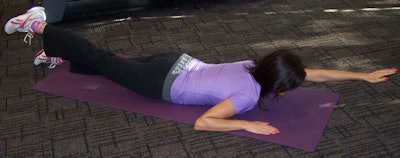 Figure 6.
Figure 6.Opposite arm and leg at 45°, from the prone position
While lying facedown on the floor, take one arm and extend it overhead, and lift the opposite leg 6 inches off the ground. To start the exercise, extend the right arm out at a 45° angle from the shoulder. At the same time, extend the left leg out to a 45° angle from the hip. When ready, bring the right arm up, lifting from the shoulder, and reach out at a 45° angle as far as possible while lifting the left leg from the glute. Raise the leg up and push back as far as possible.
As in the previous two exercises, the key is not just to lift up, but to extend as far as possible as you raise the leg and arm. (Go through a range of motion and lift only to comfort level. You will be able to increase range of motion and intensity as you progress.)
Do eight repetitions. After eight, alternate and change sides, doing the left arm and right leg and keeping them at a 45° angle as you go through the movement (figure 7).
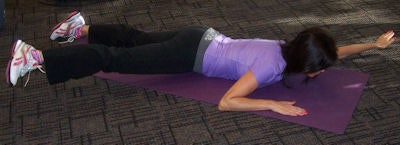 Figure 7.
Figure 7.Opposite arm and leg at 90°, from the prone position
While lying facedown on the floor, bend your right arm at 90° from the shoulder and elbow. At the same time, move the left leg out to a 90° angle from the hip and bend it at a 90° angle at the knee. When ready, bring the right arm up, lifting from the shoulder and keeping the arm at a 90° angle through the full range of motion. Lift your arm as high as possible, while also lifting your left leg from the glute and keeping it at a 90° angle at the hip and knee.
The key to this exercise is to make sure the ankle and knee are lifted at the same time, and there is no rotation of the hips or lifting of the hip off the ground. Movement should be done only from activating the glute (butt). You should feel the glute doing all the work. If the knee rises first or the ankle rises first, the exercise is incorrect. At first, you may only get the lower leg an inch or two off the ground -- this is OK. Range of motion will increase from continued work.
Do eight repetitions. After eight, alternate and change sides (figure 8).
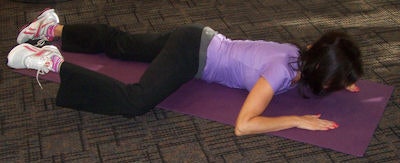 Figure 8.
Figure 8.By incorporating these simple movements, you will notice an improvement in hip mobility, core stability, and flexibility through a wide range of movements. When you first start, it may take a few extra minutes to learn the routine and movement patterns, but once you do, this training program can be done in six to eight minutes for improved fitness, movement, and performance.
Doug Wuebben is a registered cardiac sonographer who performs adult and pediatric echocardiograms in South Dakota and can be reached at [email protected]. Mark Roozen is a strength coach with the Cleveland Browns and also the owner and president of Performance Edge Training Systems (PETS). He can be reached at [email protected].





